The best universal remote control

By Adrienne Maxwell
This post was done in partnership with Wirecutter. When readers choose to buy Wirecutter's independently chosen editorial picks, Wirecutter and Engadget may earn affiliate commission. Read the full guide to universal remote controls.
If your home entertainment system is more complex than the typical media player/TV/soundbar combo and you need a universal remote to control all your gear—including a few smart-home devices—we recommend the Logitech Harmony Companion. While no single DIY universal remote is perfect for everyone, the Companion combines a good physical design with the flexibility to control a variety of devices.
The two-piece Logitech Harmony Companion system, which consists of a hub and a handheld remote, can control up to eight AV components, and it works with IR, Wi-Fi, and Bluetooth devices, which gives it more flexibility than is available with most budget remotes. You can also use a smartphone/tablet app to control your system. The Harmony Companion integrates with Alexa, Google Assistant, and several do-it-yourself home-automation hubs and smart devices, such as lights, locks, thermostats, and motorized shades. The remote lacks backlighting, and Logitech's app-based setup can sometimes be frustrating, but this system still delivers the best combination of features, flexibility, and control that we've found for the price.
If all of your devices can be controlled by standard infrared technology (as opposed to Bluetooth or Wi-Fi) and you don't need smart-home control, the Logitech Harmony 665 is a great choice. It's capable of controlling up to 10 AV devices, it features an easy-to-read, backlit color display, and the built-in Remote Assistant function is great for troubleshooting. If the remote fails to perform a task you expect it to (such as turning up the TV's volume), you can use the remote's Help button to resolve the problem quickly. However, because the Harmony 665 only works with IR-based equipment, it doesn't support smart-home devices and some streaming media players and game consoles, and it needs line of sight with your gear.
Like our top pick, the Logitech Harmony Elite is a two-piece system that uses the Harmony Hub, so you get all the same advantages. The Elite model controls up to 15 devices and adds a customizable touchscreen for even more flexibility. The remote is fully backlit and more responsive, with a nicer design that makes it feel more like the remote for a professionally installed control system—but all of that comes with a big jump in price. This is the model to get if you have a large and expanding home theater system and you want the best handheld remote.
Why you should trust us
Adrienne Maxwell is the lead editor of Wirecutter's AV team and has worked as a writer and editor in the consumer electronics industry for 20 years. During that time, she has reviewed numerous audio and video products, including virtually every major DIY universal-remote platform.
Who this is for
In this era of smart TVs, streaming media players, and soundbars, we enjoy more functionality from fewer devices. The typical living-room entertainment system may include a single source device—say, a streaming media player, cable/satellite set-top box, or gaming console—plus a smart TV and a soundbar. For a setup like this, a universal remote probably isn't necessary, since basic control of these devices (such as browsing content, changing channels, and adjusting volume) is built into—or can be easily added to—the remote that came with your media player or TV.
If, on the other hand, your home entertainment system is built around an AV receiver and multiple sources, and sitting down to watch a movie requires shuffling between several remotes to switch inputs and power/control multiple components at the same time, a universal remote is exactly what you need.
A bad universal remote simply combines all the functions of several remotes into one device and does nothing to integrate those functions in a more useful way. A good universal remote not only eliminates coffee-table clutter and the remote shuffle, but also reduces button pushes by combining multiple actions into one button press. For instance, instead of having to push separate buttons to turn on your TV, switch HDMI inputs, power on your AV receiver, change inputs there, turn on your Blu-ray player, and—finally—get your movie started, a good universal remote can reduce all of that to one command (Play Movie) that you can access at the touch of a single button. The technical name for this bundling of commands is macros, but remote-control manufacturers usually call them activities or scenes. This functionality used to be reserved for high-end, professionally programmed systems, but these days relatively inexpensive remotes can do the same complex job.
Many of today's universal remotes also incorporate some degree of smart-home control so you can adjust your lighting, temperature, and security system, or even control multiroom music systems like Sonos. You can, for instance, program the system to dim the room's lighting when you launch the "Watch a movie" activity and turn it back on when you're done. However, if you're looking for advanced whole-house control, with lots of complex lighting scenes and independent control of different sources in different rooms, a do-it-yourself universal remote may not be up to the task. You may be better off turning to a local specialty AV retailer who can create a more personalized whole-house control system from a company like Crestron or Control4, which is a much more expensive solution.
Although $100 may seem like a lot of money to spend on a universal remote (especially since you can get a good streaming media player for about half that price), keep this in mind: Because your remote control is the primary device you interact with when using your home theater system, getting a single good universal remote that does the job of eight mediocre remotes is a very satisfying upgrade to that system. CNET's David Katzmaier puts it this way: "In 15-odd years of reviewing TV and home theater equipment, the one thing I always tell people to buy is a 'good universal remote.'"
How we picked and tested
If you scan Amazon and other online retailers for universal remotes, you can find a lot of low-end replacement remotes—models whose primary purpose is to replace the one the dog chewed up and do little else. These remotes aren't designed to provide a really intuitive, streamlined, activity-based experience—they're just designed to hold a lot of buttons to control your different devices (usually about four total). We were looking for something more, and these are the criteria we applied:
A universal remote control has to be, well, universal. A remote that can juggle at least eight devices at once should cover the average audio/video enthusiast's system—which may include a TV (or projector), a DVD/Blu-ray player, a cable/satellite DVR, a surround-sound receiver, and probably a media streamer (such as a Roku or Apple TV). A game console or two might also be included.
The remote should have a well-organized button layout or an on-screen display and include all the necessary buttons to perform essential tasks. The most important ones (such as volume, pause, and play) should be easily accessible. An activity-based design, as described above, is strongly preferred.
The remote should be generally easy to program. Many cheap "universal" remotes require that you press a certain combination of buttons and then input manufacturer codes for each AV device until you find one that works. This is hardly intuitive. We prefer brands that offer setup software, via either computer or app, and keep a database of manufacturer codes. There's always going to be a bit of a learning curve with any desktop or app-based software, but if you need a certificate in C++ to program your remote, that's too difficult.
The more a remote costs, the more flexibility it should have to control different kinds of devices. Most AV devices still rely on IR (infrared) control, where you must point the remote's IR transmitter directly at the device's IR receiver. It's common for lower-priced universal remotes to only work with IR devices. But a growing number of devices, especially game consoles (like the Sony PlayStation 4) and streaming media products (like some Nvidia Shield TV and Amazon Fire TV products), are controlled via Bluetooth or Wi-Fi, so you'll need a universal remote that supports those technologies. Some Wi-Fi–friendly remotes can also control smart-home devices, and some can be linked to an Alexa or Google Home product to add voice control.
In years past, if you wanted a more advanced universal remote that you could program yourself, you had many choices from brands like Sony, Pronto, URC, and UEI. But today's DIY category has dwindled to one main brand: Harmony, owned by Logitech. While the occasional new competitor still pops up (and you can read about them in the Competition section), Harmony is the king of the mountain—so selecting the best universal remote is largely a matter of selecting the right Harmony device for your needs.
To test the remotes we call in, we set each one up to control at least two different AV systems in our home. Our AV equipment consists of a mix of traditional IR devices, Bluetooth devices like the Apple TV and Nvidia Shield TV, and some Wi-Fi smart-home products. We live with each remote for a while to see how intuitive and reliable it is to use on a daily basis.
Our pick: Logitech Harmony Companion
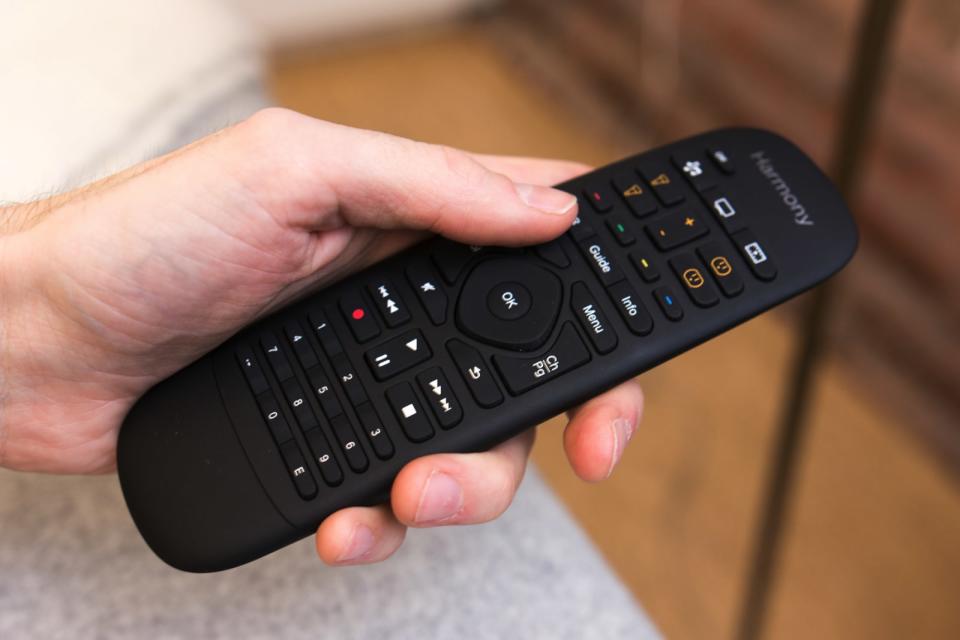
The Logitech Harmony Companion can control up to eight AV components and features activity buttons to simplify control of your whole home theater. The system works with IR, Wi-Fi, and Bluetooth devices, including a variety of smart-home products, and the free iOS/Android control app provides a second method of managing everything. You can also incorporate voice control when you integrate it with an Amazon Alexa or Google Assistant speaker. Setup is fairly straightforward using either the MyHarmony desktop software or the iOS/Android control app (though the desktop software is easier for more complicated systems). The Companion may offer more functionality than some people need, which makes it a bit more expensive than a basic universal remote.
The Harmony Companion is a two-piece system consisting of a handheld remote and a separate Hub that you place next to the AV components in your system. Unlike many universal remotes, the handheld Companion remote doesn't have a built-in IR emitter. Instead, the IR emitter, along with the Bluetooth and Wi-Fi radios, is built into the Hub. When you press a button on the Companion remote, it sends a radio signal to the Hub, telling it which button you've pushed. The Hub then emits the appropriate IR, Bluetooth, or Wi-Fi signal to control the associated components. Support for Wi-Fi and Bluetooth is a huge plus because it allows the Companion to control popular non-IR devices—such as the Sony PlayStation 4 and some media players from Nvidia and Amazon—that a basic IR remote can't.
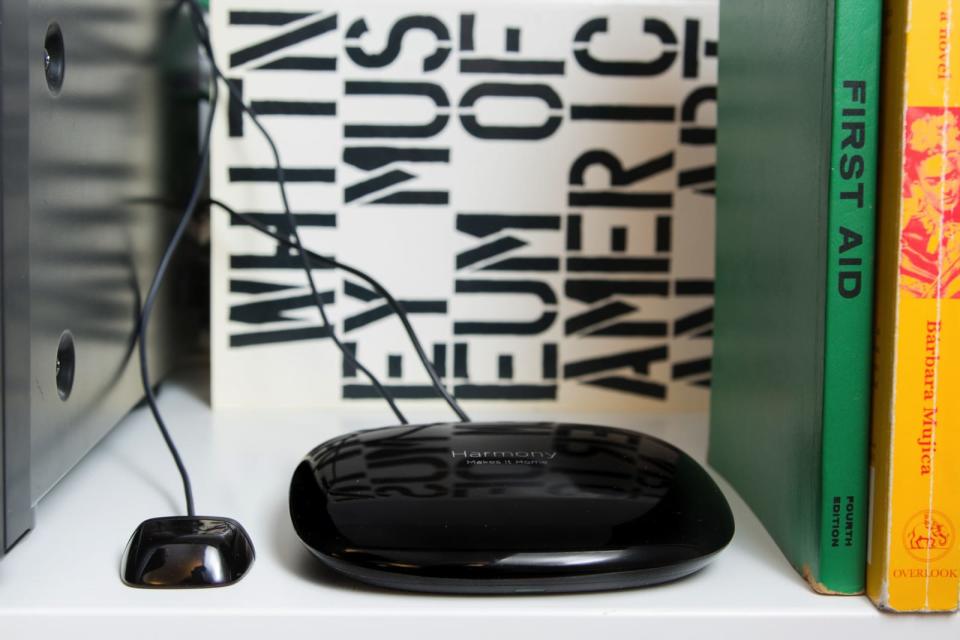
One benefit of having the IR emitters in a separate hub is that it no longer matters where you point the handheld remote. As a matter of fact, the Companion remote doesn't even need to be in the same room as the Hub, so long as you place the Hub where the IR signals it emits can reach your AV components. This location can be inside a cabinet behind closed doors, on top of a stack of AV components, or even in another part of the room. The Hub also comes with a wired IR blaster that you can point to reach components in another direction, and it has a 3.5 mm jack for adding a second blaster if necessary. Your Wi-Fi gear can be anywhere within reach of your wireless network, of course.
One of the highlights of the whole Harmony line is that these remotes are pretty simple to program, at least for universal remotes. Currently, you can choose between using the MyHarmony desktop software or the Harmony app to set up the Companion, though support for the desktop software may be waning. The first step is to add your AV devices. The software asks you to enter the manufacturer and model number of each component; it then searches for that component's remote control codes in Logitech's massive database and immediately adds the found codes to your list of devices. Logitech maintains an astoundingly large remote control code database that covers more than 270,000 home theater devices.
Once you've added all of your devices, the system guides you through the process of creating Activities. Depending on the types of components you have—perhaps a TV, a Blu-ray player, a receiver, and a cable box—Harmony suggests a number of possible Activities, such as "Watch TV" or "Listen to Music" (you can also create your own custom Activities). As you create your Activities, MyHarmony asks a series of questions, such as: "What input should your AV receiver be set to when you watch a movie?" and "Which device controls the volume?" The Harmony software performs all the complex macro calculations in the background, so you don't have to. Once you answer all the necessary questions, you're done. You can assign your newly created activity to one of the three Activity buttons located along the top of the remote.
The final step is to load your newly configured remote settings into the Hub and make sure the Hub is placed wherever you'd like it to reside. When it comes time to use the remote, just press the desired Activity button, and the Harmony turns everything on and switches each device to the correct settings. If something doesn't work the way you need it to, you can adjust the settings on-the-fly through the app.
The Companion remote has a logical button layout and includes important functions such as Menu, Exit, and Guide, and color buttons. The rubberized texture on the front and back eliminates fingerprints and reduces the chances of the remote slipping out of your hand. It uses a single CR2032 button battery that Logitech says should last up to one year.
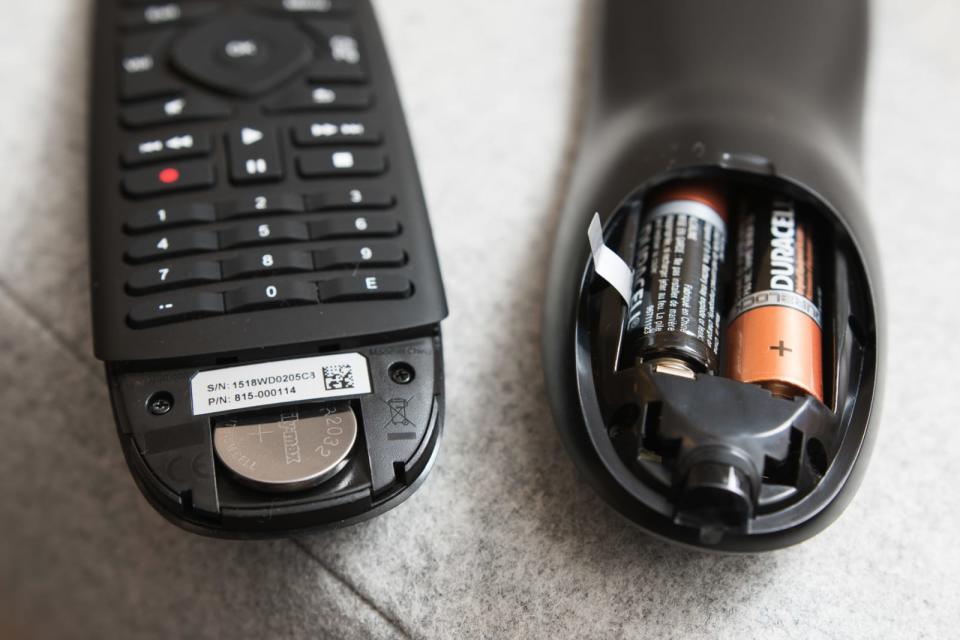
Beyond the Companion's ability to handle your AV devices, it can also serve as a basic smart-home controller. The remote itself has only a few buttons designated for smart lights and plugs, but you can manage more devices through the Harmony app. Rather than develop its own proprietary home-automation system, Logitech made the Harmony Companion compatible with several existing platforms and devices. At the moment, these include Philips Hue lighting, Nest Learning thermostats, Nest Protect smoke and carbon monoxide alarms, Honeywell's Wi-Fi thermostats, Rheem EcoNet water heaters, and smart-home hubs from Lutron Caséta. It even supports the online automation service IFTTT. You can also control your Harmony Companion with your voice by integrating it with Amazon's Alexa or Google Assistant.
The Harmony Companion provides a way of unifying control of your AV system and a basic home-automation system in a seamless, albeit limited, way. The convenience and comfort of controlling the lighting and even being able to adjust the thermostat while you're watching TV makes the Companion more than just an AV remote.
Flaws but not dealbreakers
The most egregious design flaw in the Harmony Companion is that the buttons on the handheld remote are not backlit. The raised buttons and intuitively organized layout make the remote easy to use by feel, as long as you know what each button is supposed to do. If you can never remember which is the DVR button and which is the Guide button, you'll struggle to operate the remote in the dark.
The Harmony Companion remote also lacks a customizable display, which means that less-used functions, such as changing your AV receiver's surround mode or subwoofer level, aren't accessible unless you reassign other buttons or use the app.
This model also lacks the convenient Help button available on the Harmony 665. The Harmony app does offer a Fix feature that allows you to directly access incorrect settings (power and input for components, for example), but we found it to be less intuitive than the Harmony 665's help function.
Like most of the universal remotes we've tested, the Companion remote lacks a built-in microphone to access the voice-search function in a streaming media device. So users of a Roku, Apple TV, Fire TV, or Shield TV may still need to keep their original remote nearby if they prefer voice search over text search.
Using the app to set up the Harmony Companion is simple enough, as long as everything works the way it's supposed to. But when we needed to fix buttons or troubleshoot issues, we found the app to be a bit more cumbersome to navigate, and we sometimes experienced connection issues with the Harmony servers. It was faster to use the desktop software in these cases.
Speaking of which, the MyHarmony desktop software is not compatible with the newest MacOS 10.15 (Catalina). Logitech has introduced newer software called Harmony Desktop for Catalina users, but it only works with non-Hub remotes like our budget pick, the 665. If you're a Catalina user with a Hub remote like the Companion or Elite, you now have to use the Harmony app. This suggests that Logitech isn't all that committed to the desktop software going forward.
Budget pick: Logitech Harmony 665
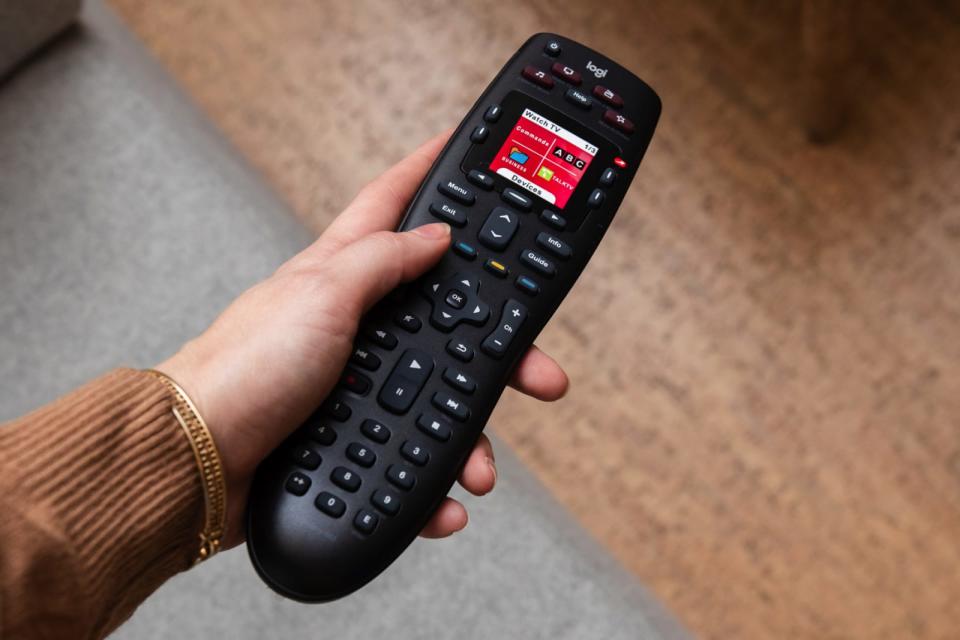
If your control needs are fairly straightforward—that is, all your AV gear can be controlled via standard infrared signals and you don't need to integrate smart-home products—the Logitech Harmony 665 is a more affordable alternative to the Harmony Companion. It can control 10 AV devices and is easy to set up via the MyHarmony desktop software. The remote has backlighting, a customizable LCD screen, and a convenient help function. However, since it can't communicate over Wi-Fi or Bluetooth, it isn't compatible with smart devices and some AV equipment, and it needs line of sight with your gear.
The Harmony 665 is a one-piece system that does not include the Hub, so you can't use the Harmony setup app on your mobile device to program it. You have to connect the remote directly to your computer via the supplied USB cable and use the MyHarmony desktop software to add devices, set up activities, and customize the LCD screen. Anytime you wish to add new devices or make changes to how the system works, you'll need to reconnect the 665 to your computer. We should mention that the MyHarmony software will not run on the newest Mac OS 10.15 (Catalina); Logitech has introduced newer software specifically for Catalina users that is called Harmony Desktop.
The remote itself is very comfortable to hold, with the most frequently used buttons—volume up/down, channel up/down, play/pause, and a cursor control pad for navigating on-screen menus and channel guides—all located within easy reach of your thumb. The buttons are distinct in shape and spaced far enough apart that it soon becomes second nature to operate the remote without needing to take your eyes off the TV, and the customizable LCD screen lets you add control options that don't have a corresponding button, such as your TV's picture-in-picture mode or your receiver's surround-sound mode.
The 665 controlled all of our IR-based components reliably—though like the Harmony Companion and most other universal remotes we tested, it does not have a microphone button for voice search.
By far, the most useful feature of the Harmony 665—the one that will keep you from pulling your hair out if you have a problem with the way your system is working—is the help function, which you access from a button above the display. If for some reason your TV doesn't turn on or the receiver doesn't switch to the correct input after you select an activity, pressing the Help button causes the Harmony 665 to immediately emit an infrared command that, ideally, rectifies the situation. Once the Harmony 665 makes its first attempt, the query "Did that fix the problem?" appears on the color screen. If you answer yes, the help screen goes away. If you answer no, the Harmony 665 asks further questions, such as "Is the AV Receiver off?" If your answer is yes, the remote sends out a command to turn the receiver back on and then once again asks, "Did that fix the problem?" Yes turns off help; no initiates another question, and so on. This built-in help function, along with the ability to easily set up Activities, makes the Harmony 665 simple enough for nearly anyone to use.
The Harmony 665 does have some drawbacks. As we've already mentioned, it's limited to controlling AV devices that accept infrared (IR) remote controls. For most people, that limitation isn't an issue because it covers the vast majority of past, current, and (most likely) future AV components. However, some popular AV devices don't use IR remotes, such as Sony's PlayStation 4, Sonos's wireless speakers, Philips Hue lighting, and certain Amazon Fire TV devices. If you currently have one of those components, you won't be able to use the Harmony 665 to control it—in other words, you're stuck using two or more remote controls.
Also, the line-of-sight nature of this IR remote means that the status of the components in your system might get out of sync when you start or end an activity if you don't keep the Harmony 665 pointed in the direction of all your equipment while it emits all of the remote control commands. The more commands that are included in the activity, the more chances there are for this to happen. Generally, the help function should be able to rectify the problem, but it's still less than perfect. You also can't use the Harmony 665 with components that are tucked away in a cabinet, unless you add your own IR extenders or an RF converter.
Finally, you have to use the supplied USB cable to connect the remote to your computer, so take care not to lose it. The cable has a Type A connector, so if you've upgraded to a computer that only has USB-C ports, you'll need an adapter. This $10 Insignia cable from Best Buy worked with the MacBook Pro laptop we used.
Upgrade pick: Logitech Harmony Elite
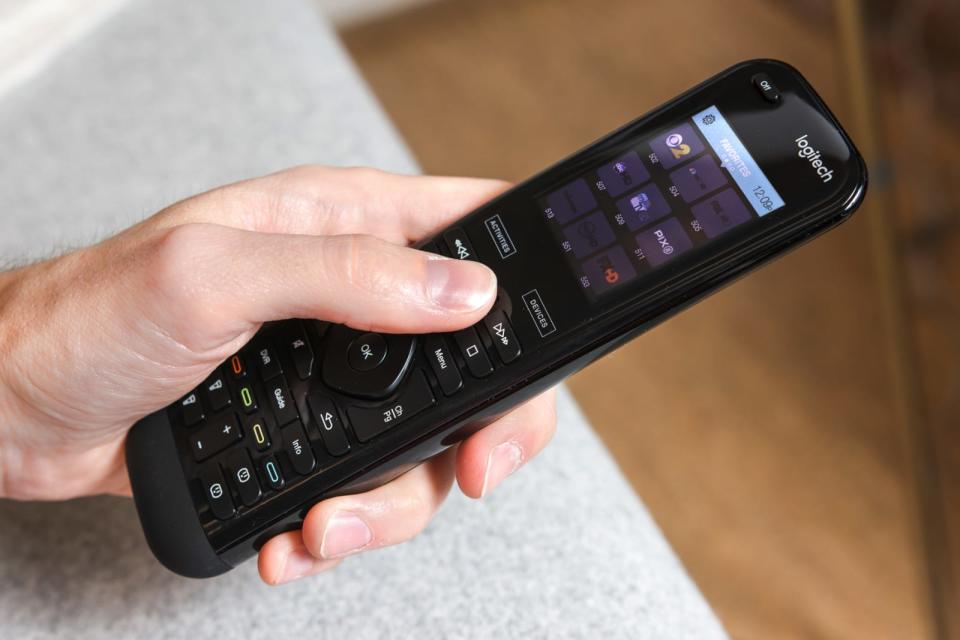
The Harmony Elite is Logitech's flagship Harmony remote. Like the Harmony Companion, it's a two-piece system built around the Hub, so it can control IR, Wi-Fi, and Bluetooth devices and does not need line of sight with your gear. Stepping up to the Elite gets you a completely customizable color touchscreen and full backlighting, plus the ability to control more components (up to 15) and to integrate even more smart-home devices into your system. Like the Companion, it also works with Alexa and Google Assistant.
The standout feature of the Elite is the color touchscreen built into the remote. Instead of pressing hard buttons for Movie, TV, or Music, for instance, you scroll up and down on the screen for your activity and tap that. The screen then switches to pages customized for that activity, and the control options can go satisfyingly deep. You can customize all the activity names or create your own. The Elite also comes with a rechargeable battery and base station, so you do not need to replace batteries as you do with the lower-priced Harmony remotes.
This is the remote to get if you have a lot of gear—it can control up to 15 devices (up from the Companion's eight-device limit), so it potentially replaces up to 15 other remotes. Like the Harmony Companion, the Elite allows you to hide your home theater equipment in a cabinet or gear closet. It comes with two IR blasters that you can position in front of the cabinet doors, which keeps your gear out of sight.
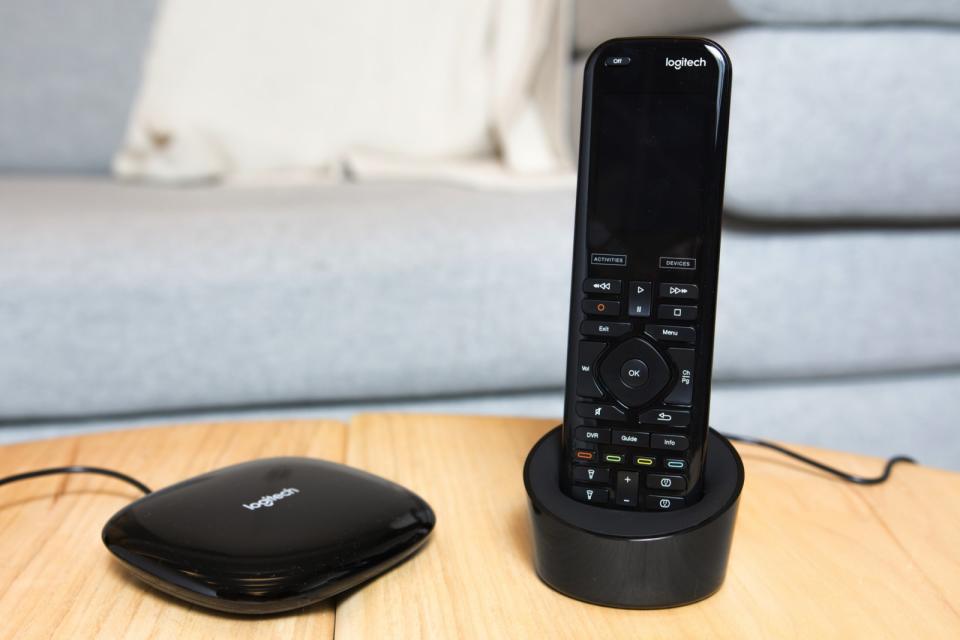
Like all the other Hub-based Harmony remotes, the Elite allows you to use the Harmony app in addition to the actual remote.
Finally, the Elite—like the Companion or any Hub-based Harmony remote—can work with a handful of smart-home devices, including Philips Hue and LIFX lights, Nest thermostats, SmartThings and Insteon hubs, Sonos wireless speakers, and even the IFTTT app. The Hub connects with all those devices via your home Wi-Fi network. With an Amazon Echo speaker and Alexa's IFTTT channel, you can create recipes for voice control of any Harmony Hub–based system. Using this setup, we created recipes to turn a complex home theater system on and off with simple voice commands.
The Elite is a pleasure to use, and it has the responsiveness and polish of a professionally installed control system, but it also costs a lot more than the Companion.
Can I use my smartphone as a remote control?
If you don't want another handheld device but like the idea of universal remote control, you might consider an app-based control system. You can purchase the Harmony Hub as a standalone unit (without a remote) and just use your mobile device with the free Harmony iOS/Android app as your remote control. Like the Companion, it can handle up to eight AV devices.
While the Harmony app is easy enough to use, we really don't recommend it—or any other app-based universal remote, such as the Pronto Peel or the Monoprice Stitch—as your sole control option. That's because using your mobile device's touchscreen as a remote requires you to look away from the TV screen and down at your device as you search for the right part of the screen to touch, making channel surfing and volume tweaking cumbersome. Plus, it's a real pain to have to wake up your phone and wait for the app to reconnect with the system anytime you want to change the channel or the volume. Sure, you can disable sleep mode on your phone, but you'll be draining your battery throughout the time you're watching a movie or show.
The competition
The Sevenhugs Smart Remote U was very close to becoming a pick. Like the Harmony Companion, this remote can control IR, Bluetooth, and Wi-Fi components (including some smart-home devices), but it doesn't need a separate hub to do so, which is a nice perk. It can control up to 20 IR devices, has a rechargeable battery, and has Spotify and Sonos support built in. We found Sevenhugs's app-based setup process to be the most intuitive platform we've tried; it was very easy to add devices, set up Scenes, create fully customized pages for the remote's touchscreen, and fix problems on the fly. And it controlled all of our devices correctly.
Unfortunately, a couple of issues hold this one back. First, the remote has no physical buttons, and both the touchscreen and the virtual buttons on it are very small. We had to look away from the TV often to make sure we carefully pressed the right button, and still we often launched the wrong command. If you don't mind the all-touchscreen approach, this may not be an issue for you—but we think that adding a few key physical buttons for volume, mute, and navigation would make a huge difference. Also, the Smart Remote U is more expensive than the Harmony Companion, currently doesn't include support for Alexa and Google Home, and natively supports fewer smart-home devices (you can add control via Webhooks, but that's more complicated).
Sevenhugs's more expensive Smart Remote X is essentially the same remote, but it adds a point mode that automatically adjusts its interface based on what device you're pointing it at. Unless you have devices scattered all around the room, we don't think this extra perk will be that useful.
The Caavo Control Center + Universal Remote combines a handheld remote and an HDMI switch/control box (with four HDMI inputs and one output). The remote is a sleek, stripped-down design with important buttons like home, microphone, volume, back, menu, and more (but no backlighting). The control box supports 4K/HDR10 pass-through, and it adds an on-screen user interface to your system through which you can easily switch sources, voice-search content across platforms, unite your streaming apps from different devices, and set up favorites. Setup is easy, and the system reliably controlled our gear without any major problems. It also works with Alexa and Google Assistant for hands-free voice control.
However, because the Caavo system is more of a control platform than a universal remote, it won't be the right fit for everyone: You can only connect HDMI sources to the control box; the remote's limited button options can make performing more advanced tasks challenging; and you have to subscribe to the Caavo service ($4 per month, $40 per year, or a one-time lifetime subscription fee of $130 at the time of this writing). Plus, adding an interface on top of your sources can slow down some processes (like voice search). But if you're looking for a highly affordable way to add more 4K/HDR-friendly HDMI inputs to your system and you like the idea of controlling your gear through an on-screen interface instead of activity buttons on a remote, the Caavo system is a simple, reliable option that works well.
The Logitech Harmony Express features built-in Alexa voice control and has a much simpler design than the Harmony Companion or Elite, with just 10 action buttons and a navigation wheel. You can control your AV system with your voice by pressing the remote's Alexa button and saying commands like "Turn on Fire TV," "Open Netflix app," or "Watch ESPN." While we found this remote easy to set up and reliable in executing commands, its limited button options make performing more advanced tasks challenging, and this system is totally locked into the Alexa ecosystem. Plus, it is no longer listed on Logitech's Harmony page, so it may already be nearing its end.
Universal Remote Control (the company) used to offer a variety of good DIY remotes, but the company now focuses on the professional-installation market. You can still find some older DIY URC remotes online but at elevated prices.
RCA offers a four-device-capable "universal" replacement remote, as well as two-, three-, and six-device versions. The bigger RCA remotes even have programmable macros that let you power up several devices with one button press, but they aren't capable of the kind of switching or complex control the Harmony remotes can accomplish.
Like RCA, One for All has several universal remotes in its lineup (for sale in the United States, at least), including the Simple 4; these have similarly limited programmability and support only three or four devices.
This guide may have been updated by Wirecutter. To see the current recommendation, please go here.
When readers choose to buy Wirecutter's independently chosen editorial picks, Wirecutter and Engadget may earn affiliate commissions.
